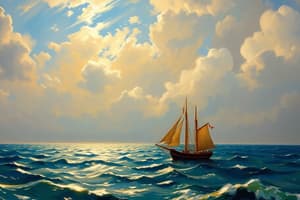Podcast
Questions and Answers
What was the primary goal of Cristobal Colon's voyages?
What was the primary goal of Cristobal Colon's voyages?
- To establish colonies in the New World.
- To map the Atlantic Ocean.
- To spread Christianity to new lands.
- To find a new sea route to Asia for valuable goods. (correct)
The largest owner of property in the New World was King Charles III of England.
The largest owner of property in the New World was King Charles III of England.
False (B)
Who led the first European expedition to round the Cape of Good Hope, opening the sea route to Asia?
Who led the first European expedition to round the Cape of Good Hope, opening the sea route to Asia?
Bartolomeu Dias
According to Catholic doctrine, a person who died before atoning for all of their sins was sent to ______.
According to Catholic doctrine, a person who died before atoning for all of their sins was sent to ______.
Match the following explorers with their significant achievements:
Match the following explorers with their significant achievements:
Which of the following factors contributed to the Catholic Church's reputation for corruption during the Middle Ages?
Which of the following factors contributed to the Catholic Church's reputation for corruption during the Middle Ages?
The Iberians generally replaced existing local power structures with entirely new systems in the regions they conquered.
The Iberians generally replaced existing local power structures with entirely new systems in the regions they conquered.
Apart from finding spice and silk, what was another motivation for Cristobal Colon's voyage to Asia?
Apart from finding spice and silk, what was another motivation for Cristobal Colon's voyage to Asia?
Flashcards
Bartolomeu Dias
Bartolomeu Dias
Portuguese explorer who first rounded the Cape of Good Hope, opening a sea route to Asia.
Columbus's Goal
Columbus's Goal
To find a new sea route to Asia, especially India, for valuable goods.
Treaty of Tordesillas
Treaty of Tordesillas
Agreement between Spain and Portugal dividing the world outside Europe between them.
Ferdinand Magellan
Ferdinand Magellan
Signup and view all the flashcards
Portuguese expeditions cause
Portuguese expeditions cause
Signup and view all the flashcards
Who claimed Brazil?
Who claimed Brazil?
Signup and view all the flashcards
Simony
Simony
Signup and view all the flashcards
Who were the Lollards?
Who were the Lollards?
Signup and view all the flashcards
Study Notes
- Western legend stated the ocean boiled or formed at the equator
- Bartolomeu Dias was a Portuguese navigator who led the first European expedition to round the Cape of Good Hope
- Dias opened the sea route to Asia via the Atlantic and Indian oceans
- Cristobal Colon sought a new sea route to Asia, specifically India
- Colon wanted to bring back goods like spices, silk, and gems
- Isabella of Castile was not called King Isabella
- The Treaty of Tordesillas divided the world outside of Europe between Spain and Portugal
- The treaty was signed June 7, 1494, in Tordesillas, Spain
- Magellan finally accomplished what Columbus set out and failed to do
- Spain’s two most significant kingdoms were Castile and Aragon
- Portuguese nobility organized expeditions in search of plunder because they were economically weakened after the Black Death
- Ferdinand Magellan's crew were the first people to circumnavigate the globe
- Pedro Alvares Cabral claimed Brazil for Portugal
- The qualification for being viceroy or governor-general was loyalty to the crown and a distinguished record of public service
- The largest owner of property in the New World was King Charles III of England
- The Iberians imposed a new governance system based largely on the existing local power structures in the regions they conquered which included slave labor
- Catholic sacraments include: Baptism, Confirmation, and Penance
- Catholic doctrine stated a person who died before atoning for their sins was sent to purgatory
Catholic Church
- The Catholic Church developed a reputation for corruption in the Middle Ages
- This reputation was due to the selling of indulgences, pluralism, simony, and opulence of church officials
- The Lollards were a group of English Christians who questioned the Catholic Church
- They established religious beliefs in the late 14th and early 15th centuries
- The Lollards were followers of John Wycliffe, a theologian who translated the Bible into English
- Pope Alexander VI used Church money for his illegitimate children, including a daughter with whom he had been accused of having sexual relations
- Martin Luther's basic doctrine was justification by faith alone
- Salvation is achieved solely through faith in Jesus Christ, not by good works or adherence to Church traditions
- The 95 theses were a series of statements written by Martin Luther in 1517
- The statements questioned the practices and beliefs of the Roman Catholic Church, specifically indulgences and salvation
- King Henry VIII was labeled the “Defender of the Faith”
- John Calvin taught the concept of predestination
- The Council of Trent was a group of religious officials, including bishops and cardinals
- They met periodically in Trent, Italy to discuss Catholic teachings and determine what needed change
- Witch hunts were a series of investigations and persecutions of people accused of witchcraft that took place in Europe and the Americas from the 14th to 18th centuries
- The Columbian Exchange was the global exchange of plants, animals, diseases, people, and ideas between the Americas, Europe, and Africa
Studying That Suits You
Use AI to generate personalized quizzes and flashcards to suit your learning preferences.





